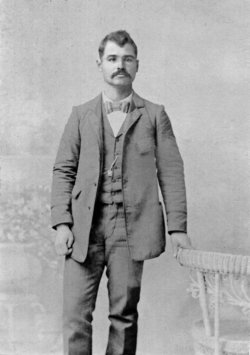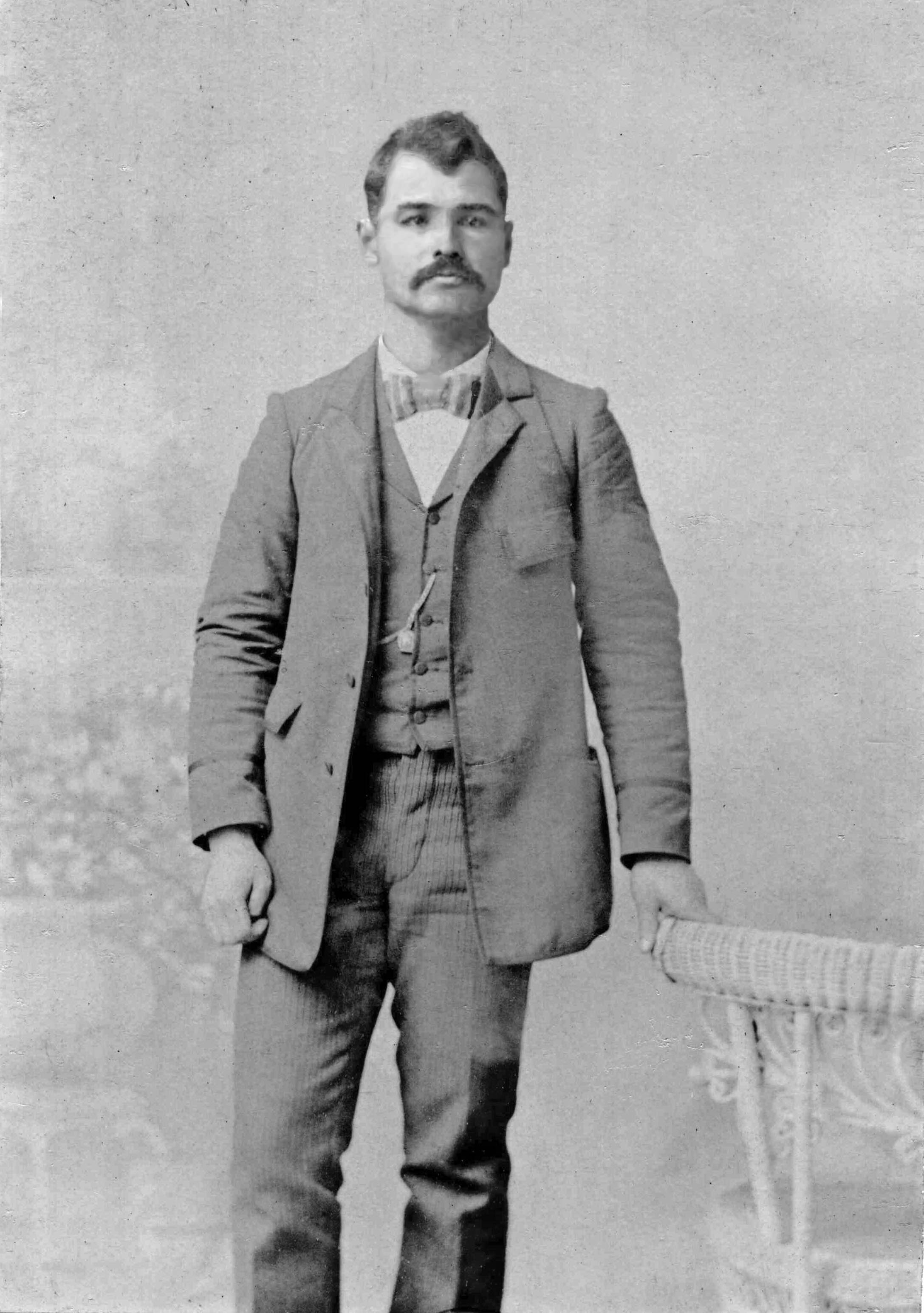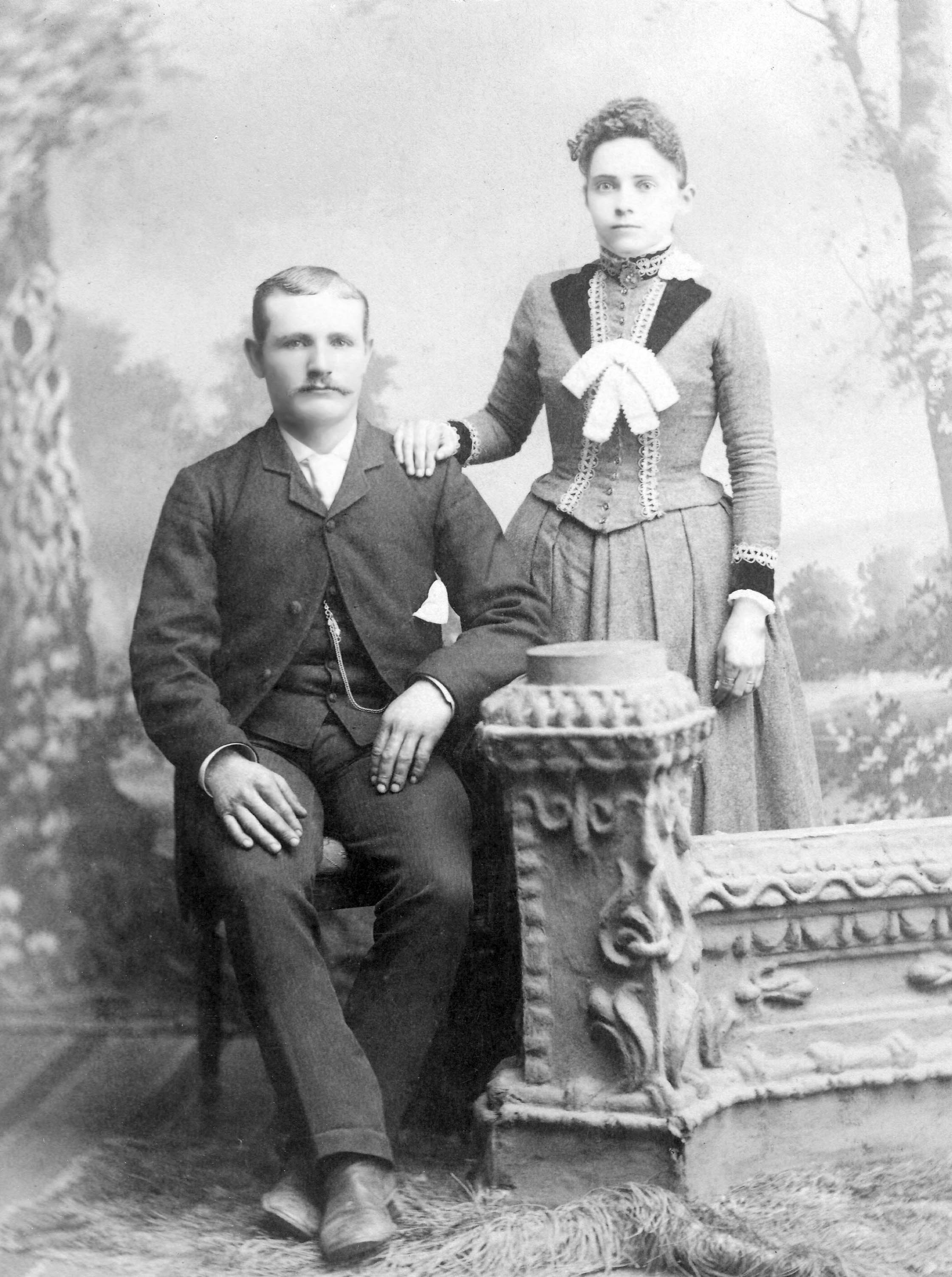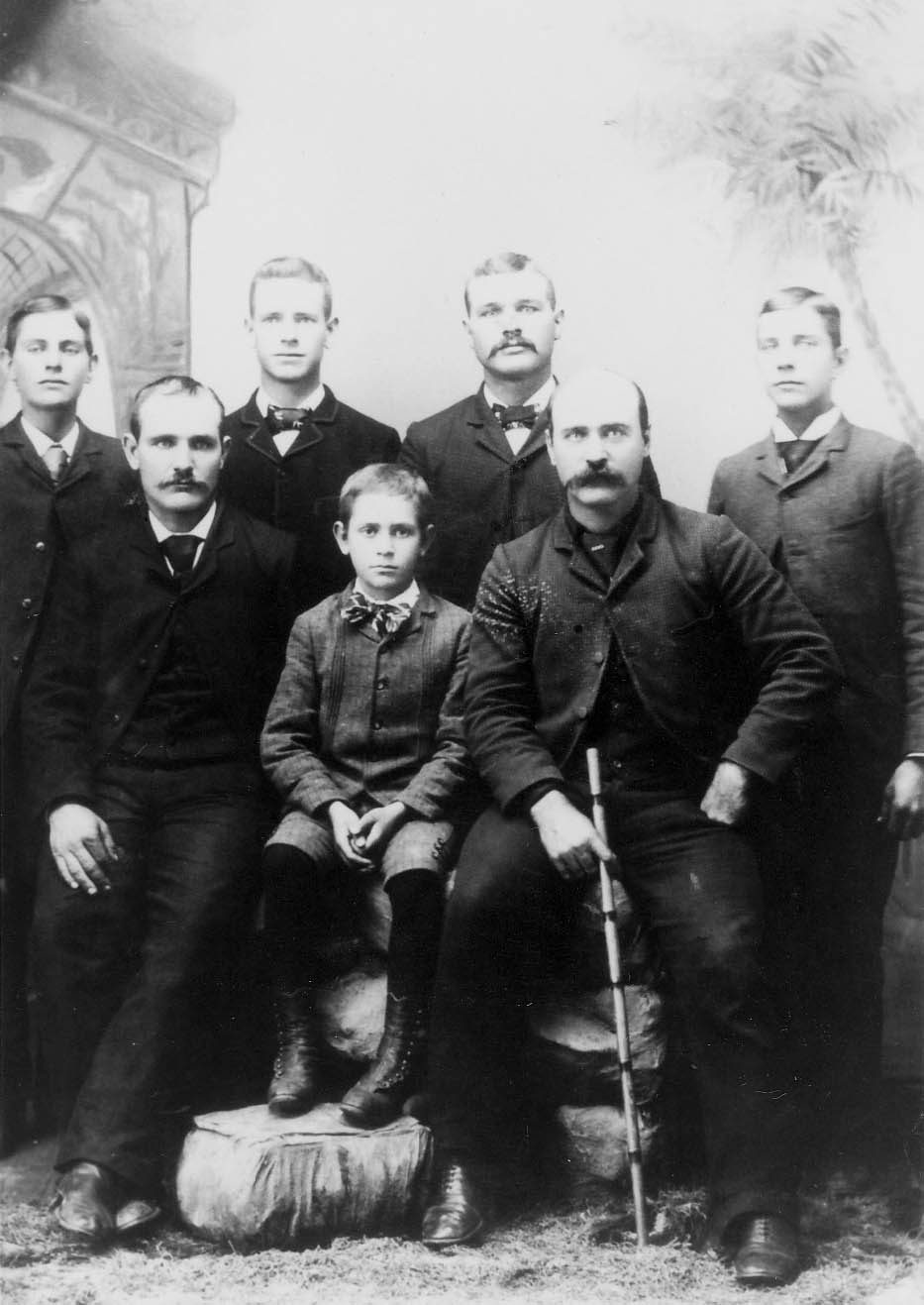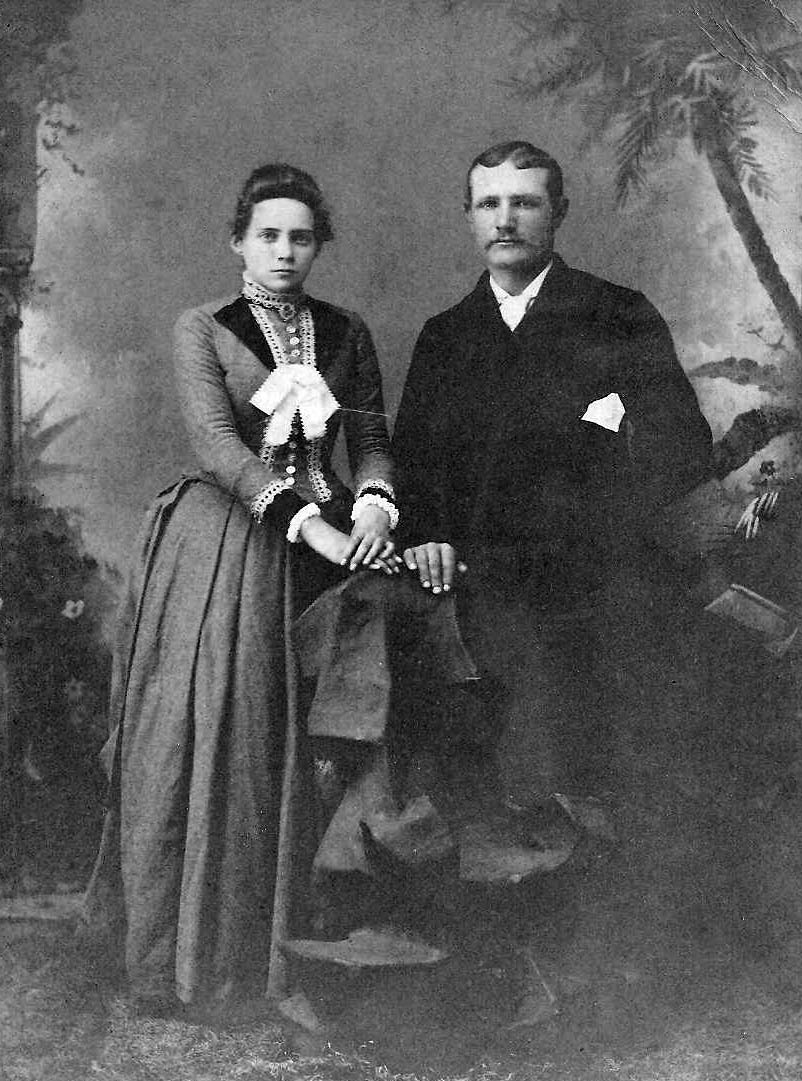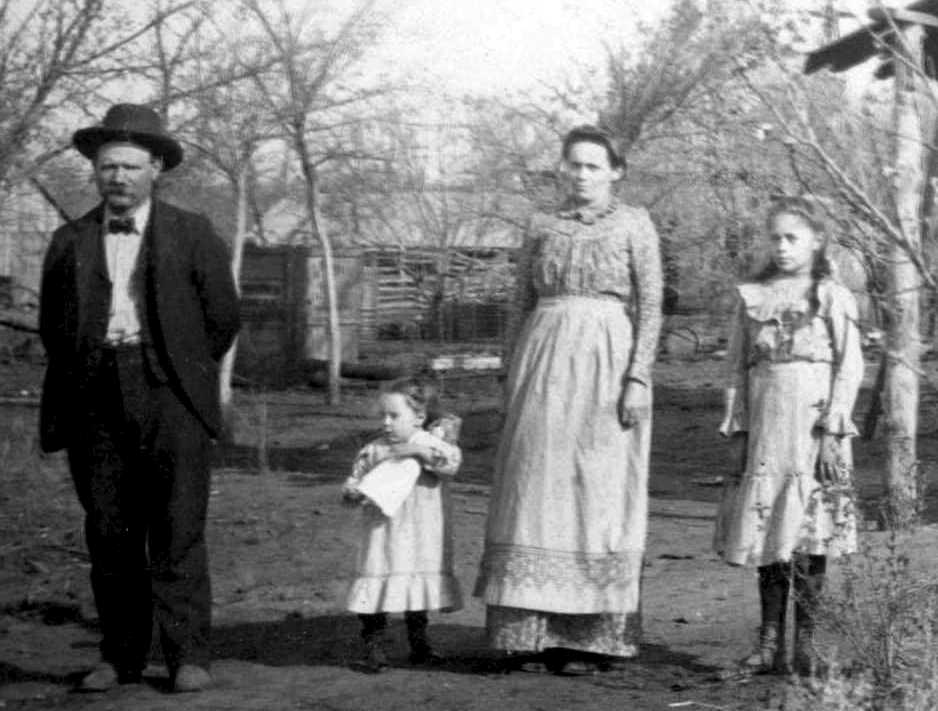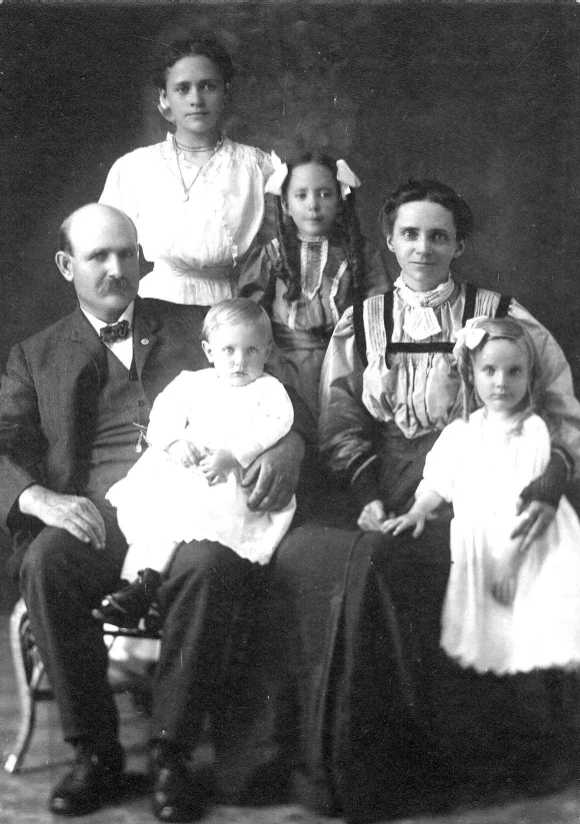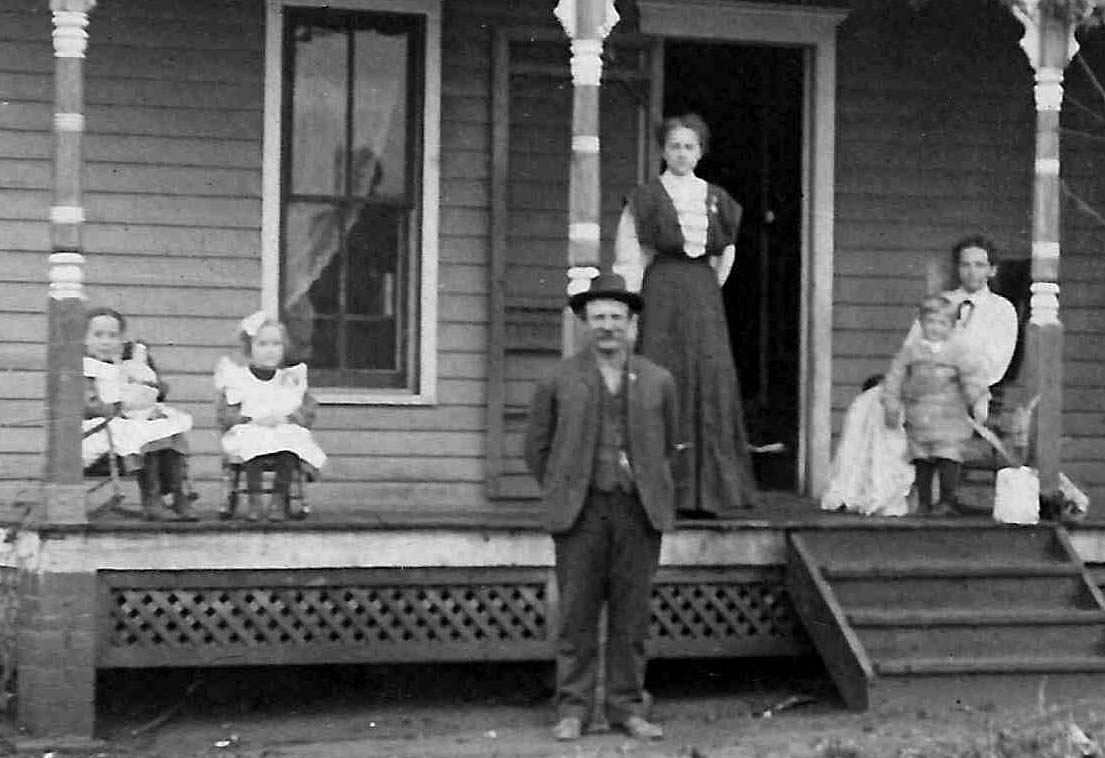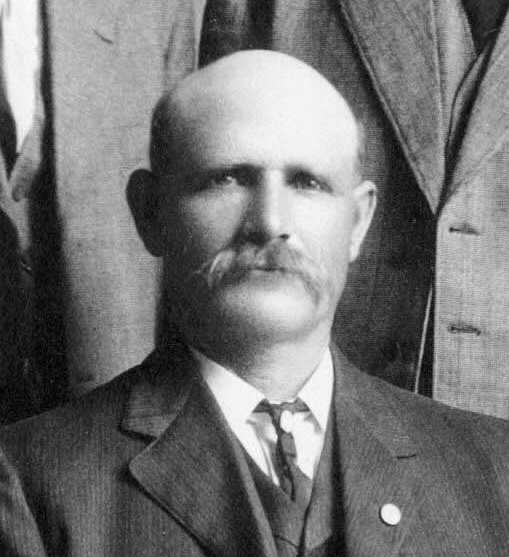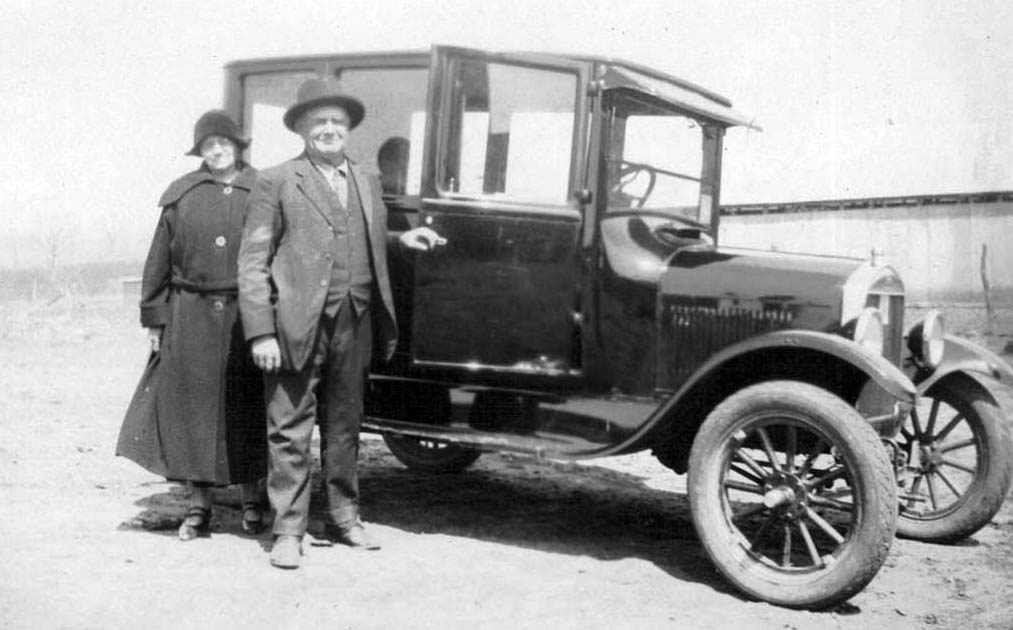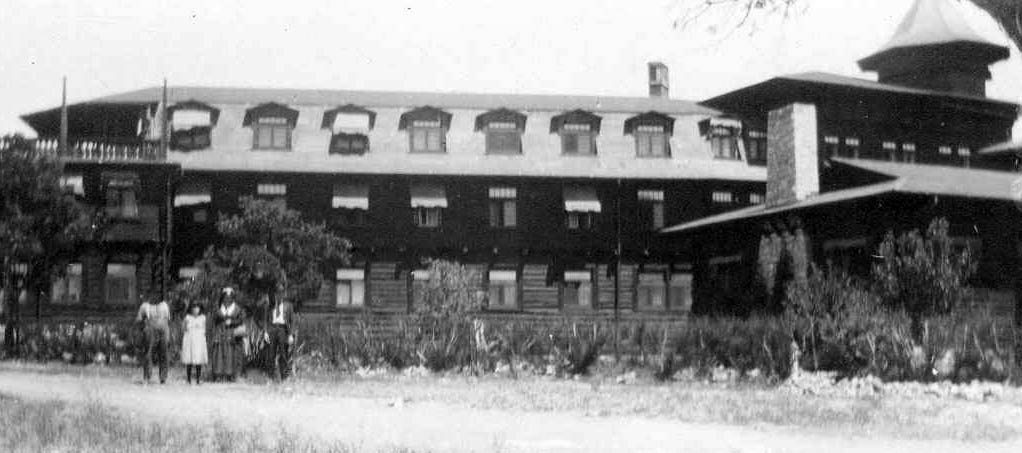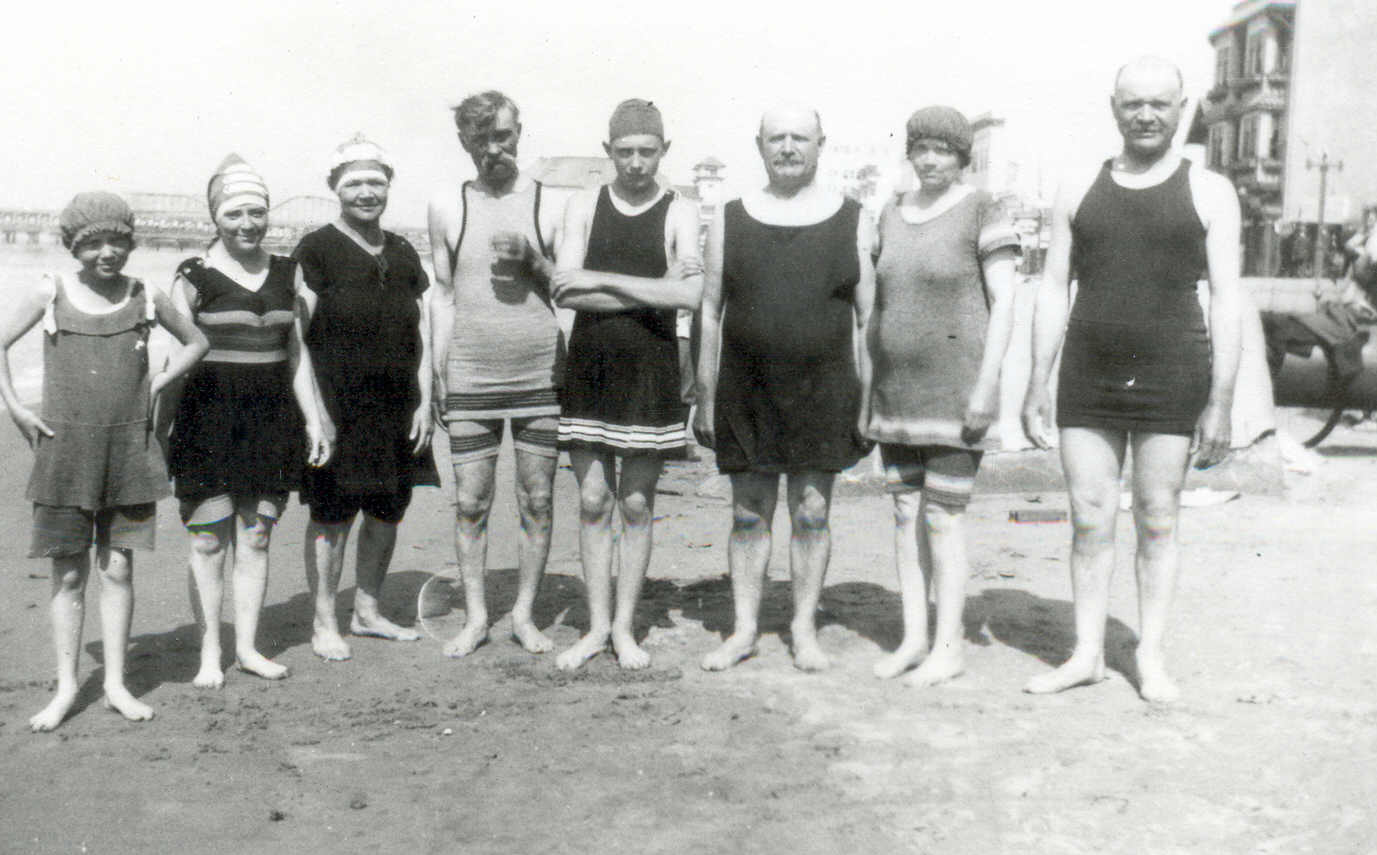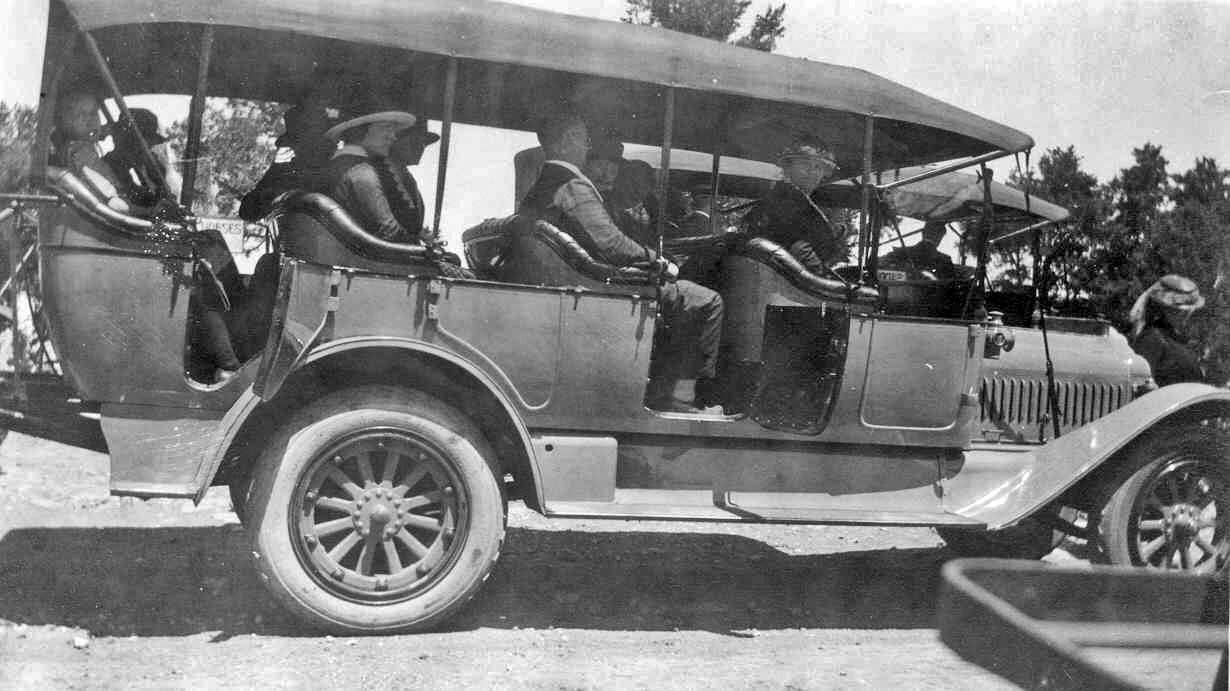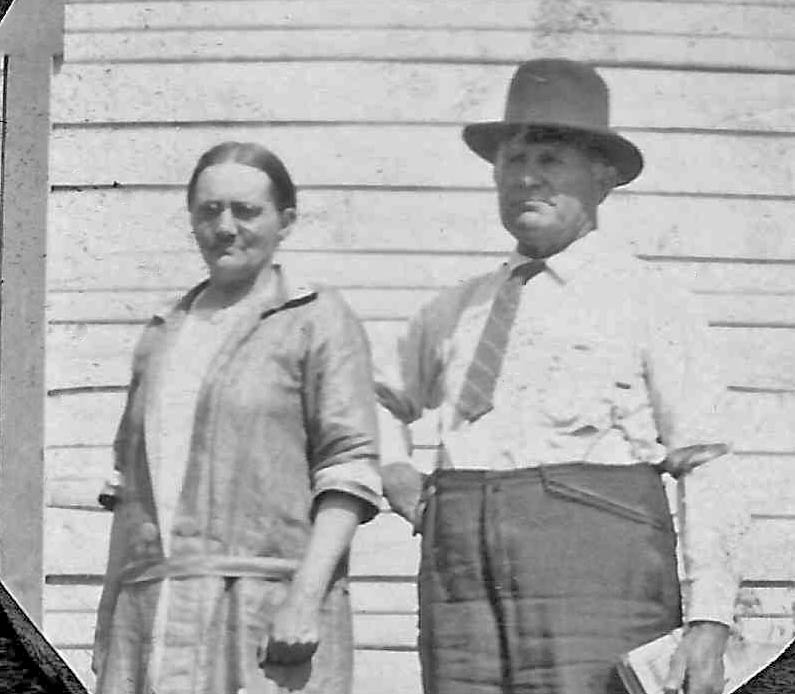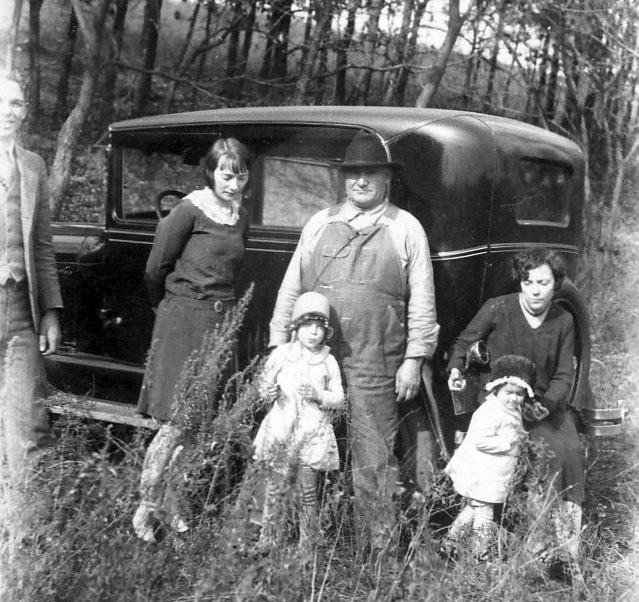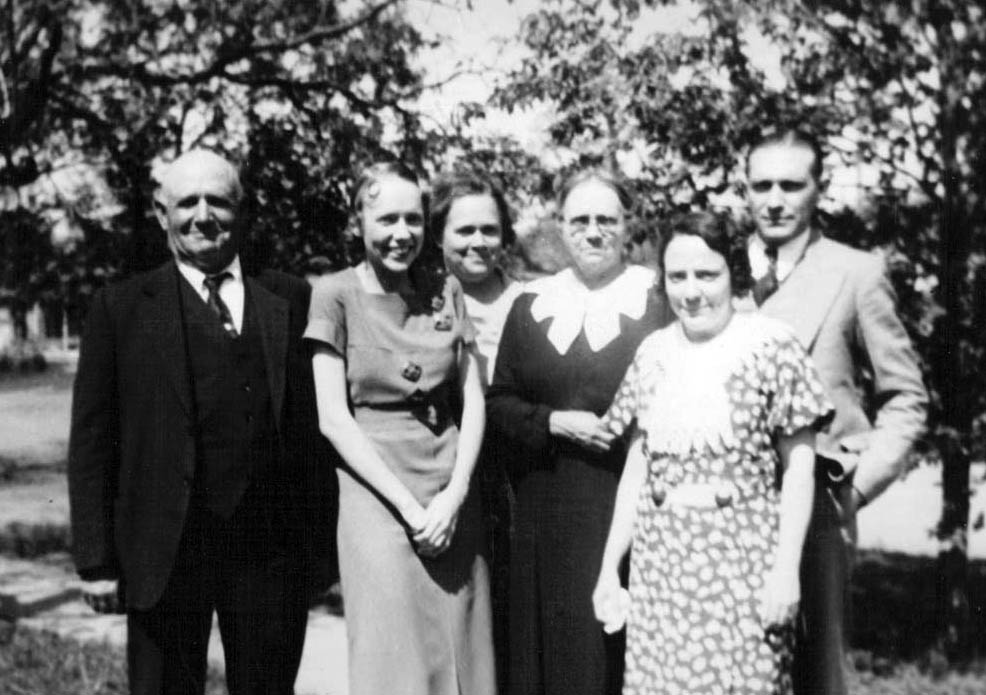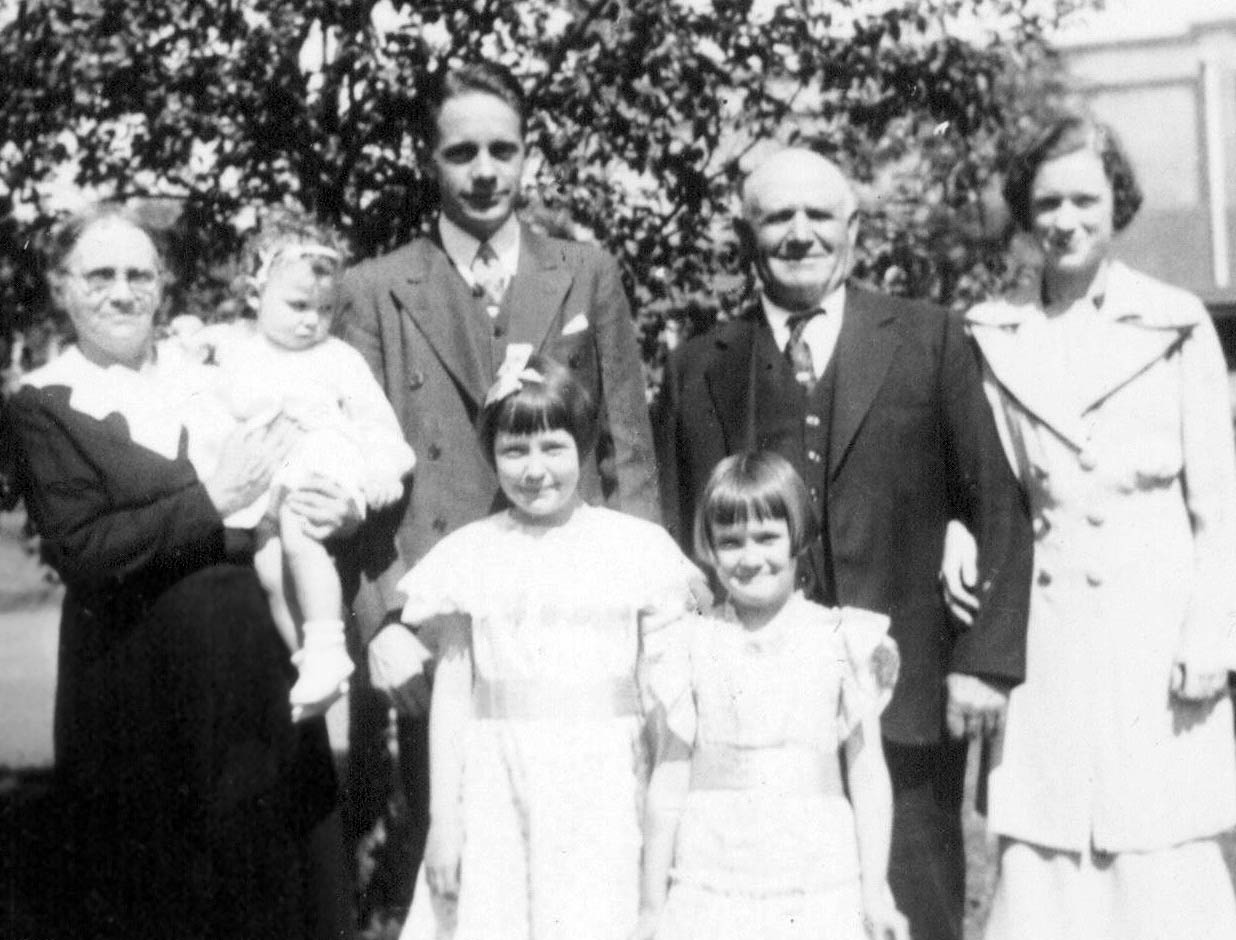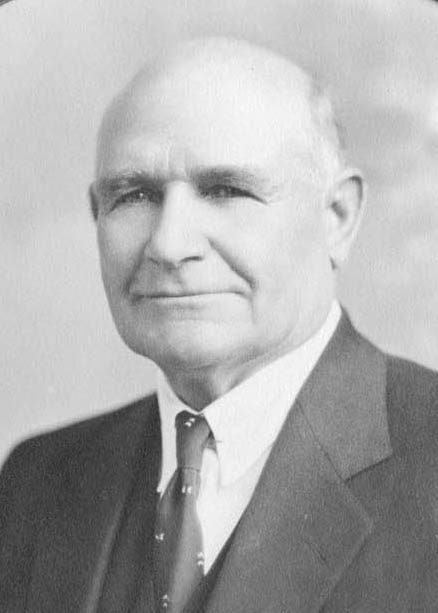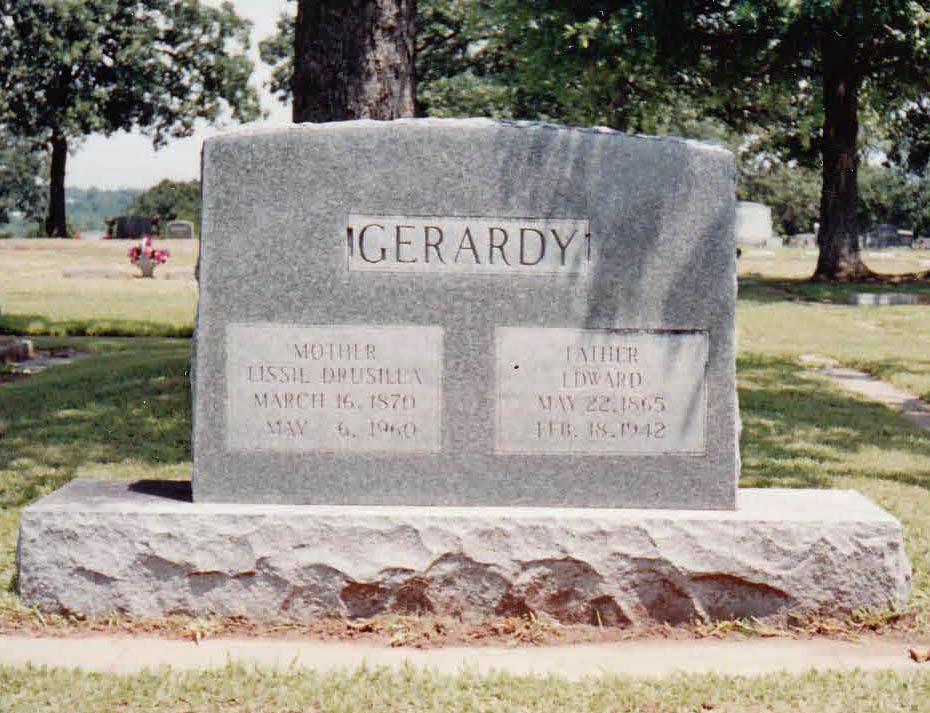Edward Gerardy , son of Peter and Caroline (Christel) Gerardy, was born May 22 , 1865 , at Wathena, Doniphan County, Kansas … His name was spelled "Edouard" in the Peter Gerardy Bible , but he was always called "Ed".
Ed moved with his parents from Wathena to Washington County, Kansas, in 1870 and five years later to the farm [near Fact] in Clay County. His only schooling was received at the country school near their home. All of Peter 's sons were expected to remain at home until they were 21 to help with the farming, after which they were given a team of young horses and a wagon and permitted to leave home to make their own way. He moved onto the farm across the road north of his parents' farm and it was there he and Lissie were married by their pastor, Rev. Harvey Knight of the [Goshen] Congregational Church [on January 28, 1889]. They lived there for three years and during that time their first child, Grace, was born.
He longed, though, for land of his own to farm so when Indian lands in Oklahoma Territory began to open for settlement, he and his brother Will made the trip down to Oklahoma with a team and wagon, or they may each have had a team and wagon. They arrived in Lincoln County too late for the "land run" [of September 22, 1891], but Ed traded a wagon, set of harness and three horses to two rival claimants who divided the property in exchange for their headright to a farm in the Forest community. It was located seven miles south of Chandler in the SE¼ of Sec. 17, T13N, R4E. It remained in the family's possession until 1964 when it was sold. Ed's brother, William, traded for a farm directly across the road south of Ed.
Ed went back to Kansas on the train from Guthrie and then returned in a covered wagon loaded with household goods and supplies. Upon his return, Ed built a substantial log cabin near a good spring of water. It was a little more up-to-date than most other cabins then as it had glass in the windows and door.
After the log cabin was completed, Lissie came with their baby, Grace, by train to Guthrie and from there to Lincoln County by stagecoach. The Green family (who had come from Clay County, Kansas, too) lived north of Chandler, and although they were not directly on the stagecoach road they lived near it. Since the drive to the farm at Forest would take so long, the Greens invited Ed to bring his family to their home for the night. In those days stagecoach robberies were not -uncommon, so when Ed stopped the stagecoach on a lonely country road, the driver was very suspicious. In a very gruff voice he asked Ed what he wanted and he replied he wanted his wife and baby. The driver would not let her off the stagecoach, though, until Lissie convinced him the man was her husband.
The Indian trail from the Kickapoo reservation went right by the Gerardy home. Lissie and the children often watched the Indians riding by on their way to the Sac and Fox Indian Agency at Stroud for their government allotments. Though they were never harmed by Indians, they were always somewhat frightened. Sometimes Indians would stop to ask for water. Doors had to be kept locked because they paid no attention to doors and would walk right into the house. One day two Indian men stopped for water and saw Lissie sewing on her sewing machine. It must have been the first one they had seen as they came right back with their women and children. Lissie showed the women how the machine worked. They wanted her to make a dress for one of them, but Lissie said she was much too frightened to sew.
[In 1897 there was a tornado.] Though they were not directly in the path of the storm, they took refuge in the cellar as the storm passed by, and then they stood outside as they watched the tornado that destroyed Chandler on March 30, 1897. Ed had gone to Shawnee to trade that day, but when he saw the dark storm approaching he hurried back to the farm as quickly as he could
They lived in the cabin until 1899 when they built the main part of the big house. It included two rooms upstairs and two rooms downstairs. In the summer of 1903 the large west wing was added, and during that time the family again lived in the log house. The new wing made the house into a large and comfortable home. In early years it was painted a pretty shade of yellow with lots of white gingerbread trim, which was very popular around the turn of the century. There were three porches-on the east, south and north sides of the house. Downstairs there were three rooms—living room, bedroom and a large room in the west wing which was a combination dining room and kitchen. A stairway led to three bedrooms upstairs. The south porch was used for rocking and visiting, and the north porch led to the back yard and also contained the well. No longer did they have to carry water from the spring. Two small rooms built at opposite ends of the north porch opened into the kitchen. One was a pantry and the other was a bathroom. The bathroom had no modern plumbing, but it did afford ' a place to take baths in privacy,
All of the farm was cleared and put into production except a strip along the west side where there was a deep ravine which the family called "The Canyon". Big oak trees and sandstone boulders lined the sides of the canyon not too far from the house. Located at the head of the canyon was the spring from which they carried their water in .the early years. water from the spring ran in a small stream along the canyon floor providing water for the farm animals and an excellent wading place for children. It was a fun place to roam, have a picnic lunch, carve initials on the sandstone (still visible today) and a favorite place to play when friends came to visit. Long after the family moved away, but while the farm remained in their possession, it was still fun to take the children and go out to "The Canyon" for a picnic lunch and hike through the ravine.
Ed and Lissie were charter members and organizers of the first church in that part of the county in 1893. It was called the Forest Congregational Church. From 1893 until 1899 the congregation met in the homes of the members. Ed gave lumber from his farm and labor to help build the church. Sadly, the first funeral held in the new church was for their second daughter, Pearlie, who died of membranous croup (diphtheria) on November 3, 1899. Another daughter, Goldie May, died September 15, 1911. These two daughters were buried in the Forest Cemetery near the church and less than a mile from their home.
Church records show Ed served as Sunday School Superintendent, Church Treasurer, and was on the Church Board almost continuously. Lissie taught Sunday School classes and sometimes attended district and state meetings as a delegate. She and Ed always had family Bible reading and prayers in the home and taught their children to be industrious, thrifty, honest and loyal to each other.
Ed also furnished lumber and labor to build the Forest School, which was located just across the road east of their farm. All the children attended grade school there, and Grace [later] taught in that school.
Not one ever to be idle, he often engaged in other business ventures. He was a sales representative for Page Fences and built them for other farmers in the area. He was also an agent for Dodd and Struthers Lightning Rod Company when practically every home in the country sprouted lightning rods. At one time he even worked for a while as a wholesale grocery salesman.
In 1913 Ed bought another farm in the Kickapoo Valley community [for $5,500]. Ed was a successful farmer and was one of the first to recognize the need for soil conservation practices. He was a good mechanic and was always making improvements on his machinery. On April 20, 1920, he was granted a patent on an automatic block indicator for hay balers. [US1337553; Canada 219024. He sold the patent for an unknown sum but was asking $55,000, ten times the cost of a farm. Afterwards the family moved to a house in Chandler, while keeping the two farms, and bought train tickets for a month-long tour of the western states.]
In 1921 he took all his family, except Grace who was married and unable to leave her family, to California to visit his sister, Anna Faivre, and his brothers William and Emile. They went by train and had a memorable vacation. Anna and her family lived in Long Beach at the time. William was also at Long Beach and Emile had just moved to Sacramento. [They went on to San Francisco and returned by way of Colorado, where his wife Lissie had cousins on her mother’s side. They toured the sights everywhere they went.]
The previous year [1920] Ed and his family had moved to Chandler where they lived for five years, though he continued to farm both farms with the aid of hired hands. Then in 1925 they moved to the Kickapoo Valley farm where the rich bottom land grew alfalfa and grain crops. Cotton had been the main cash crop at Forest and for many years produced bountiful crops. But it was an "upland farm" suited only to cotton farming and in the early 1920s the arrival of the boll weevil brought an end to cotton farming. The land was planted to grass and returned to cattle grazing. In 1937, after twelve years at Kickapoo Valley, they returned to their home at Forest and turned the farming activities over to their son, Loren.
On January 29, 1939, they were privileged to celebrate their Golden Wedding anniversary. The affair was hosted by their son and daughters at the home of Grace Potter in Chandler. A tea was held in the afternoon for friends and relatives. Preceding the dinner that evening a short service was conducted by the Methodist minister, Rev. Fenn, and Ed presented his bride of fifty years with a new gold wedding ring. They were attended by Ed's brother, William, and his wife, Myrtle. Will had been best man at his brother's wedding fifty years earlier. Another brother, Frank, his wife Maude, and their son Dale were also present. A buffet dinner was served to thirty-seven relatives.
Ed was a jolly, friendly, honest, hard-working, thrifty and trustworthy man. He was devoted to his family and liked nothing better than to have them all home as often as possible. Though he had no formal musical training he sang and played the accordion to the great delight of his children and grandchildren. On February 18, 1942, Ed died at his home at Forest following a stroke. Services were conducted at the Methodist Church in Chandler.
Note from Gerardy Family History, by Evelyn (Potter) Park, 1995, p.164:
Grandfather Edward Gerardy loved to play his accordion and entertain their visitors. He always played this song [Sweet Evelina] for me, Evelyn, when I visited, and called me his sweet Evelina, so I always thought of it as "my" song. However, other grandchildren tell me he played it for them merely substituting their names for Evelina. Virginia (Pinkston) Busby of Albuquerque, New Mexico is now in possession of that old accordion. Grandfather's youngest daughter, Christel Gerardy Brown of Oklahoma City (1998) bought him a new accordion in his later years and is now in possession of that one.
Additional notes:
To hear Sweet Evelina sung, visit https://www.youtube.com/watch?v=Uv_g26skMFs. To her it played on a small accordion, visit https://www.youtube.com/watch?v=9Hz6_DkwbOw
Ed's voter certificate of 1940 describes him as being age 75, 5'8" tall, blue eyes, 196 lbs, and a Democrat. Lissie's voter certificate describes her as age 70, 5' tall, blue eyes, 135 lbs, and a Democrat.
Ed’s death certificate describes the cause of death as “myocardial failure due to apoplexy,” meaning a stroke.
In 1947 his estate sold the Gerardy Kickapoo farm, while retaining mineral rights. In 1964 it sold the Gerardy Forest Farm, while retaining the mineral rights.
Edward Gerardy , son of Peter and Caroline (Christel) Gerardy, was born May 22 , 1865 , at Wathena, Doniphan County, Kansas … His name was spelled "Edouard" in the Peter Gerardy Bible , but he was always called "Ed".
Ed moved with his parents from Wathena to Washington County, Kansas, in 1870 and five years later to the farm [near Fact] in Clay County. His only schooling was received at the country school near their home. All of Peter 's sons were expected to remain at home until they were 21 to help with the farming, after which they were given a team of young horses and a wagon and permitted to leave home to make their own way. He moved onto the farm across the road north of his parents' farm and it was there he and Lissie were married by their pastor, Rev. Harvey Knight of the [Goshen] Congregational Church [on January 28, 1889]. They lived there for three years and during that time their first child, Grace, was born.
He longed, though, for land of his own to farm so when Indian lands in Oklahoma Territory began to open for settlement, he and his brother Will made the trip down to Oklahoma with a team and wagon, or they may each have had a team and wagon. They arrived in Lincoln County too late for the "land run" [of September 22, 1891], but Ed traded a wagon, set of harness and three horses to two rival claimants who divided the property in exchange for their headright to a farm in the Forest community. It was located seven miles south of Chandler in the SE¼ of Sec. 17, T13N, R4E. It remained in the family's possession until 1964 when it was sold. Ed's brother, William, traded for a farm directly across the road south of Ed.
Ed went back to Kansas on the train from Guthrie and then returned in a covered wagon loaded with household goods and supplies. Upon his return, Ed built a substantial log cabin near a good spring of water. It was a little more up-to-date than most other cabins then as it had glass in the windows and door.
After the log cabin was completed, Lissie came with their baby, Grace, by train to Guthrie and from there to Lincoln County by stagecoach. The Green family (who had come from Clay County, Kansas, too) lived north of Chandler, and although they were not directly on the stagecoach road they lived near it. Since the drive to the farm at Forest would take so long, the Greens invited Ed to bring his family to their home for the night. In those days stagecoach robberies were not -uncommon, so when Ed stopped the stagecoach on a lonely country road, the driver was very suspicious. In a very gruff voice he asked Ed what he wanted and he replied he wanted his wife and baby. The driver would not let her off the stagecoach, though, until Lissie convinced him the man was her husband.
The Indian trail from the Kickapoo reservation went right by the Gerardy home. Lissie and the children often watched the Indians riding by on their way to the Sac and Fox Indian Agency at Stroud for their government allotments. Though they were never harmed by Indians, they were always somewhat frightened. Sometimes Indians would stop to ask for water. Doors had to be kept locked because they paid no attention to doors and would walk right into the house. One day two Indian men stopped for water and saw Lissie sewing on her sewing machine. It must have been the first one they had seen as they came right back with their women and children. Lissie showed the women how the machine worked. They wanted her to make a dress for one of them, but Lissie said she was much too frightened to sew.
[In 1897 there was a tornado.] Though they were not directly in the path of the storm, they took refuge in the cellar as the storm passed by, and then they stood outside as they watched the tornado that destroyed Chandler on March 30, 1897. Ed had gone to Shawnee to trade that day, but when he saw the dark storm approaching he hurried back to the farm as quickly as he could
They lived in the cabin until 1899 when they built the main part of the big house. It included two rooms upstairs and two rooms downstairs. In the summer of 1903 the large west wing was added, and during that time the family again lived in the log house. The new wing made the house into a large and comfortable home. In early years it was painted a pretty shade of yellow with lots of white gingerbread trim, which was very popular around the turn of the century. There were three porches-on the east, south and north sides of the house. Downstairs there were three rooms—living room, bedroom and a large room in the west wing which was a combination dining room and kitchen. A stairway led to three bedrooms upstairs. The south porch was used for rocking and visiting, and the north porch led to the back yard and also contained the well. No longer did they have to carry water from the spring. Two small rooms built at opposite ends of the north porch opened into the kitchen. One was a pantry and the other was a bathroom. The bathroom had no modern plumbing, but it did afford ' a place to take baths in privacy,
All of the farm was cleared and put into production except a strip along the west side where there was a deep ravine which the family called "The Canyon". Big oak trees and sandstone boulders lined the sides of the canyon not too far from the house. Located at the head of the canyon was the spring from which they carried their water in .the early years. water from the spring ran in a small stream along the canyon floor providing water for the farm animals and an excellent wading place for children. It was a fun place to roam, have a picnic lunch, carve initials on the sandstone (still visible today) and a favorite place to play when friends came to visit. Long after the family moved away, but while the farm remained in their possession, it was still fun to take the children and go out to "The Canyon" for a picnic lunch and hike through the ravine.
Ed and Lissie were charter members and organizers of the first church in that part of the county in 1893. It was called the Forest Congregational Church. From 1893 until 1899 the congregation met in the homes of the members. Ed gave lumber from his farm and labor to help build the church. Sadly, the first funeral held in the new church was for their second daughter, Pearlie, who died of membranous croup (diphtheria) on November 3, 1899. Another daughter, Goldie May, died September 15, 1911. These two daughters were buried in the Forest Cemetery near the church and less than a mile from their home.
Church records show Ed served as Sunday School Superintendent, Church Treasurer, and was on the Church Board almost continuously. Lissie taught Sunday School classes and sometimes attended district and state meetings as a delegate. She and Ed always had family Bible reading and prayers in the home and taught their children to be industrious, thrifty, honest and loyal to each other.
Ed also furnished lumber and labor to build the Forest School, which was located just across the road east of their farm. All the children attended grade school there, and Grace [later] taught in that school.
Not one ever to be idle, he often engaged in other business ventures. He was a sales representative for Page Fences and built them for other farmers in the area. He was also an agent for Dodd and Struthers Lightning Rod Company when practically every home in the country sprouted lightning rods. At one time he even worked for a while as a wholesale grocery salesman.
In 1913 Ed bought another farm in the Kickapoo Valley community [for $5,500]. Ed was a successful farmer and was one of the first to recognize the need for soil conservation practices. He was a good mechanic and was always making improvements on his machinery. On April 20, 1920, he was granted a patent on an automatic block indicator for hay balers. [US1337553; Canada 219024. He sold the patent for an unknown sum but was asking $55,000, ten times the cost of a farm. Afterwards the family moved to a house in Chandler, while keeping the two farms, and bought train tickets for a month-long tour of the western states.]
In 1921 he took all his family, except Grace who was married and unable to leave her family, to California to visit his sister, Anna Faivre, and his brothers William and Emile. They went by train and had a memorable vacation. Anna and her family lived in Long Beach at the time. William was also at Long Beach and Emile had just moved to Sacramento. [They went on to San Francisco and returned by way of Colorado, where his wife Lissie had cousins on her mother’s side. They toured the sights everywhere they went.]
The previous year [1920] Ed and his family had moved to Chandler where they lived for five years, though he continued to farm both farms with the aid of hired hands. Then in 1925 they moved to the Kickapoo Valley farm where the rich bottom land grew alfalfa and grain crops. Cotton had been the main cash crop at Forest and for many years produced bountiful crops. But it was an "upland farm" suited only to cotton farming and in the early 1920s the arrival of the boll weevil brought an end to cotton farming. The land was planted to grass and returned to cattle grazing. In 1937, after twelve years at Kickapoo Valley, they returned to their home at Forest and turned the farming activities over to their son, Loren.
On January 29, 1939, they were privileged to celebrate their Golden Wedding anniversary. The affair was hosted by their son and daughters at the home of Grace Potter in Chandler. A tea was held in the afternoon for friends and relatives. Preceding the dinner that evening a short service was conducted by the Methodist minister, Rev. Fenn, and Ed presented his bride of fifty years with a new gold wedding ring. They were attended by Ed's brother, William, and his wife, Myrtle. Will had been best man at his brother's wedding fifty years earlier. Another brother, Frank, his wife Maude, and their son Dale were also present. A buffet dinner was served to thirty-seven relatives.
Ed was a jolly, friendly, honest, hard-working, thrifty and trustworthy man. He was devoted to his family and liked nothing better than to have them all home as often as possible. Though he had no formal musical training he sang and played the accordion to the great delight of his children and grandchildren. On February 18, 1942, Ed died at his home at Forest following a stroke. Services were conducted at the Methodist Church in Chandler.
Note from Gerardy Family History, by Evelyn (Potter) Park, 1995, p.164:
Grandfather Edward Gerardy loved to play his accordion and entertain their visitors. He always played this song [Sweet Evelina] for me, Evelyn, when I visited, and called me his sweet Evelina, so I always thought of it as "my" song. However, other grandchildren tell me he played it for them merely substituting their names for Evelina. Virginia (Pinkston) Busby of Albuquerque, New Mexico is now in possession of that old accordion. Grandfather's youngest daughter, Christel Gerardy Brown of Oklahoma City (1998) bought him a new accordion in his later years and is now in possession of that one.
Additional notes:
To hear Sweet Evelina sung, visit https://www.youtube.com/watch?v=Uv_g26skMFs. To her it played on a small accordion, visit https://www.youtube.com/watch?v=9Hz6_DkwbOw
Ed's voter certificate of 1940 describes him as being age 75, 5'8" tall, blue eyes, 196 lbs, and a Democrat. Lissie's voter certificate describes her as age 70, 5' tall, blue eyes, 135 lbs, and a Democrat.
Ed’s death certificate describes the cause of death as “myocardial failure due to apoplexy,” meaning a stroke.
In 1947 his estate sold the Gerardy Kickapoo farm, while retaining mineral rights. In 1964 it sold the Gerardy Forest Farm, while retaining the mineral rights.
Inscription
Father Edward Gerardy; May 22, 1865; Feb 18, 1942
